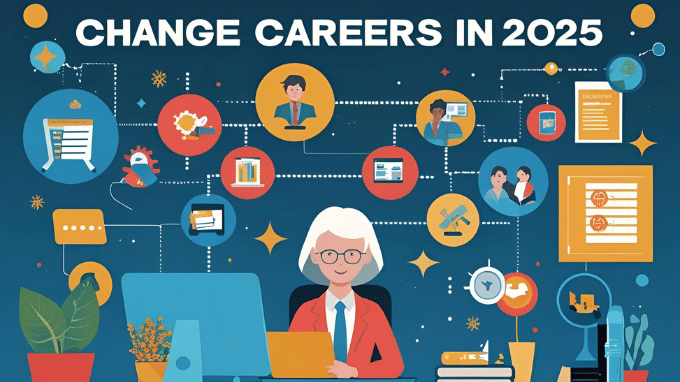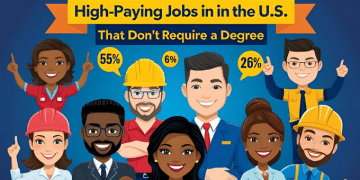How to Change Careers in 2025

Thinking about how to change careers without starting over in 2025? You’re not alone. A growing number of professionals in the U.S. are reevaluating their paths and seeking more fulfilling, flexible, or financially rewarding roles. But here’s the catch—most people don’t want to go back to entry-level jobs, take on student debt, or spend years retraining. The good news? You don’t have to.
Changing careers doesn’t mean starting over anymore. With the rise of transferable skills, online certifications, and a more dynamic job market, it’s entirely possible to pivot into a new role—without erasing everything you’ve already built. The key is strategy, not reinvention.
In this guide, you’ll learn:
- Real-life strategies for identifying and marketing your transferable skills
- Which industries in the career change USA landscape are most open to newcomers
- How to upskill without going back to school
- How to rebrand your resume and LinkedIn for a new field
- The top best jobs for career changers in 2025
- How to switch careers in 2025 without burning out or going broke
Why More Americans Are Switching Careers in 2025

According to a recent report from LinkedIn, nearly 40% of U.S. workers are considering a career pivot this year. Post-pandemic burnout, automation, and the rise of remote work have all changed how we view traditional career paths. Workers want flexibility, purpose, and growth—and they’re willing to switch fields to get it.
Some common reasons for making the leap:
- Feeling stuck or underpaid in a current role
- Burnout or lack of work-life balance
- Layoffs or job insecurity in certain industries
- Desire to align work with personal values or interests
- New opportunities created by tech or remote-first companies
The challenge? Making the move without losing momentum.
Read next: Top 10 Highest-Paying Jobs In 2025: Earn $200K With These Career Paths!
How To Change Careers In 2025
Step 1: Audit Your Transferable Skills
Before you rush into a new field, take a step back and assess what you already bring to the table. One of the most overlooked assets in a career change is your existing skill set.
What Are Transferable Skills?
These are skills that can move with you from one job to another—even across industries. Think:
- Project management
- Client communication
- Budgeting and forecasting
- Writing and editing
- Problem-solving
- Leadership and team coordination
- CRM or data tools (e.g., Salesforce, Excel)
Use your resume and performance reviews to help you identify patterns. Then, cross-reference job listings in your target field to see where your skills already align.
Step 2: Research Career Paths That Welcome Newcomers
The career change USA landscape is more flexible than ever. Many employers are open to nontraditional backgrounds, especially in industries that are growing fast and struggling to fill roles.
Here are some fields where career changers thrive:
- Tech and IT – coding, QA testing, cybersecurity, UX design
- Digital marketing – SEO, content writing, social media
- Healthcare support – medical billing, health coaching, administration
- Education and training – corporate learning, edtech, tutoring
- Project management – in tech, construction, and creative industries
These roles value real-world experience and soft skills just as much as technical knowledge. And many offer on-ramps through short-term certifications or apprenticeships.
Step 3: Upskill Without Going Back to School
No, you don’t need a new degree to make a career change. What you need is proof of competence—and today, that can come from much shorter (and cheaper) options.
Options to build your credibility:
- Google Career Certificates (IT Support, UX, Data Analytics)
- Coursera and edX courses in business, tech, and marketing
- Project-based learning (build a portfolio site, launch a blog, freelance)
- Volunteer or pro bono work to gain experience
This step helps you bridge the gap—and build confidence. The goal is to show potential employers you’ve done the work, even if you haven’t held the title.
Read next: How To Build A Powerful Professional Network That Accelerates Your Career
Step 4: Rebrand Your Resume and LinkedIn
This is where many people get stuck. They assume their past experience “doesn’t count” in a new field. But it absolutely does—as long as you reframe it.
Resume Tips for Career Changers:
- Start with a summary that clearly states your target industry and value
- Focus your experience around skills and achievements, not job titles
- Highlight relevant projects, certifications, and metrics
- Drop outdated or irrelevant details that don’t support your new direction
Your resume isn’t a biography—it’s a pitch. Make every line support the story you’re trying to tell now.
Step 5: Network With Purpose
When you’re changing fields, the hidden job market becomes even more important. You’re less likely to get callbacks from online applications—and more likely to land roles through referrals, conversations, and visibility.
Here’s how to build a new network:
- Connect with people in your target field on LinkedIn
- Join niche groups or Slack communities
- Attend webinars or local meetups (virtual or IRL)
- Ask for informational interviews (keep them short and curious)
People hire who they trust. The more familiar your name becomes in the space, the more opportunities will come your way.
Read next: How to Find High-Paying Jobs in the USA: 2025 Career Hacks That Work
Best Jobs for Career Changers in 2025
Some roles are particularly friendly to those entering from other industries. Here’s a quick look at the best jobs for career changers this year:
| Job Title | Why It’s Great for Career Changers |
| UX Designer | Values empathy, research, and creativity—skills found in many other fields |
| Digital Marketing Specialist | Strategic thinking and communication are key—easy to transition into from writing, PR, sales |
| Project Manager | Great fit for organizers, coordinators, and people with leadership skills |
| Data Analyst | High demand, with many bootcamp and cert options—math skills are a bonus, not a must |
| Customer Success Manager | Strong people skills and client experience translate well |
Many of these roles are remote-friendly, growth-oriented, and accessible via nontraditional paths.
How to Switch Careers in 2025 Without Burning Out
Changing careers is exciting—but it can also feel overwhelming. Here’s how to protect your energy and sanity during the transition:
- Start small – Freelance, consult, or take a course before quitting your job
- Set clear goals – Know your timeline and what success looks like
- Don’t compare – Everyone’s path is different; stay focused on yours
- Celebrate small wins – Every step counts, from updating your resume to landing your first interview
Most importantly, give yourself permission to evolve. Your next chapter doesn’t have to erase your past—it can build on it.
You’re Not Starting Over—You’re Leveling Up
The idea that you have to start from scratch to change careers is outdated. In 2025, you can transition with strategy, confidence, and support—without going back to square one.
By identifying your transferable skills, targeting flexible industries, and building proof through modern learning platforms, you can pivot without panic. Whether you’re moving from hospitality to tech or from sales to education, your experience matters.
If you’re wondering how to change careers without starting over, remember this: your story isn’t starting again—it’s taking a new direction. And you’re the one writing it.





